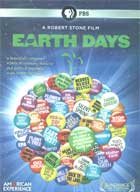
Earth Days 2010
Distributed by PBS
Produced by Robert Stone
Directed by Robert Stone
DVD, color and b&w;, 102 min.
Jr. High - Adult
American Studies, Environmental Studies
Date Entered: 09/20/2010
Reviewed by Dan DiLandro, E.H. Butler Library, State University of New York College at BuffaloA largely engaging (and unexpectedly not at all dogmatic) look at the environmental movement from the post-WWII years, through 1960s culture and 1970’s “Earth Day,” to the more recent politicizing of the costs of “being green,” Earth Days traces the development of the modern eco-movement and its attendant activism.
A documentary from the almost always excellent PBS American Experience, Earth Days is somewhat unique in both its narrative as well as its focus. Primarily, the film’s subjects (if they may be called that) are nine experts and/or luminaries in various fields of the environmental movement. Meet “The Conservationist,” “The Motivator,” “The Organizer,” et al. No mere and simple celebrities, these experts know their game, so to speak, and will be easily accessible by both their individual accomplishments and also the straightforward telling of their experiences. For example, “The Biologist” is Paul Ehrlich, author of 1968’s The Population Bomb—a text which predicted mass global starvation and other devastating effects of over-population within a generation; “The Politician” is former congressperson Pete McCloskey, the co-chair of 1970’s “Earth Day” and the co-author of that era’s “Endangered Species Act”;--nothing but heavy hitters here!
The film’s focus, though, is intriguing (for this often too didactic genre) as well: Earth Days does not attempt to coerce any agendas, conclusions or, really, any specific points of view. The film follows the general pattern of allowing the subjects to speak about some of their upbringing, their professional lives, what brought them into the environmental movement, and what they did about it. Within this simple framework, though, various audiences will truly be treated to some surprising (and surely self-discovered) conclusions. After all, what would junior high students, college attendees, or their parents respond to “The Organizer” (Dennis Hayes, National Coordinator of “Earth Day”) when he notes: “When I was born, Strontium-90 didn’t exist. When I was a teenager, every living creature had Strontium-90 in its bones…”? It is a testament to the elevated sensibilities of the film that major moments in and themes about the environmental movement are touched upon, but tediously dogmatic conclusions are never necessarily pronounced—only logically allowed to unfold on their own. Rachel Carson’s Silent Spring is alluded to, but the film and its speakers never conclude, “And you see how she was right?!”, preferring to present reasoned arguments and measured personal stories that lead genuinely to this conclusion. (This review freely admits something of a bias, though; in these days of climate change, it is difficult not to find some truth in the earliest predictions of the eco-movement. Perhaps, then, other viewers may feel coerced into pre-fabricated conclusions somewhat, but I truly do not believe that this would be the case.)
The film similarly deals lightly with the always-amusing 1950s and ‘60s images of mass consumerism and excess as well as with the somewhat more ominous archival material that highlights “better living through chemistry” and the sense (as “The Astronaut” notes) that the atom was going to be the “salvation of humanity.”
Truly evocative vignettes will provide a fine forum for discussion; and while younger audiences may not be aware of some of the key points in the environmental movement (or, alternately, older audiences may not recall the importance of a space photograph of the whole earth), Earth Days will provide for a good deal of discussion that bridges itself from the environmental movement to consumerism to economic prognostication to politics. What might any groups of viewers think about President Carter’s installing solar panels on the White House, and of President Reagan’s taking them down? How would they react – and how would this discussion lend itself to other areas of study addressed above?
At points like these, of course, the film necessarily alludes to more political issues, but these are presented in a logical manner: Equal time is given to the conspicuous consumption of a ridiculously overstocked 1950s refrigerator as is in mentioning that the first “Earth Day” fell on the 100th birthday of Vladimir Lenin! A light, but telling, touch.
Where the film is more political—its talk of corporations stemming the eco-movement for fear of diminished profits—its criticisms fit well into the narrative; indeed, the film would be remiss not to address this issue: “We lost 30 years because both [political] sides ossified into their ideologies…. We’re in this together.” Might a more balanced statement be possible in most other strongly partisan films of this nature?
Asking about the nature of the world, its inhabitants, our wants, how we define happiness, and what we are looking for at the cost to the earth as an entirety; employing well-known and accomplished speakers using a moderate, intelligent tone; and utilizing beautiful, engaging, and sometimes amusing images, Earth Days is certainly to be highly recommended for libraries that specialize in American and, especially, environmental studies.
Awards
- Closing Night Film, 2009 Sundance Film Festival
- The Sheffield Green Award, 2009 Sheffield Doc/Fest